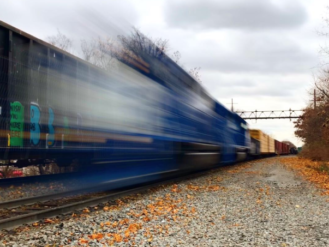As the Waterfront Spruces Up, Let’s Not Forget Its Past
Novelist Jennifer Egan and four fellow "water obsessives" explore the changing terrain of our shoreline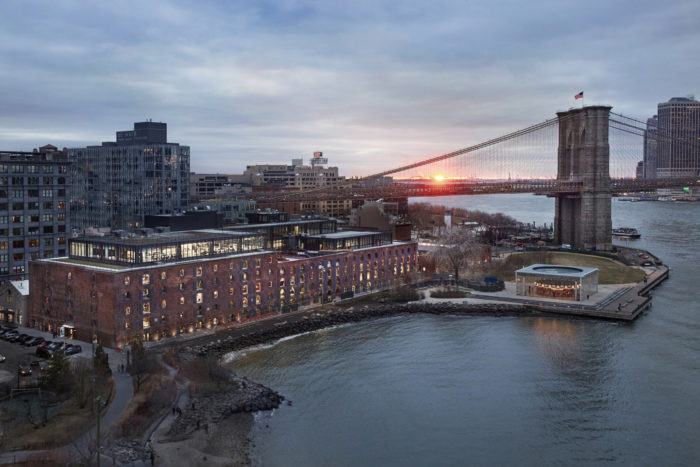
The restored Empire Stores building on the waterfront in Dumbo, which houses offices, retail stores, and restaurants (Photo by John Muggenborg/johnmuggenborg.com)
Brooklyn’s relationship with its 113 miles of waterfront has made a dramatic about-face. For a generation or more, the borough had turned its back on what was a long, grimy strand of dilapidated industrial areas, toxic canals, and neglected wetlands. Now, suddenly, Brooklynites are turning to face the waterfront as a place to live, work, learn, and play. (And for some, to make a fortune in real estate.)
A total makeover is underway. Brooklyn Bridge Park, not long ago a stretch of decrepit piers, offers 1.3 miles of recreational enticements. Once-isolated Red Hook is now a restaurant destination, connected to points north and south by the NYC Ferry. The shoreline-hugging Belt Parkway, by reputation a traffic-choked conduit to JFK airport, was extolled by the New York Times last weekend as a “great scenic ride,” our answer to the Pacific Coast Highway.
Great, right? Yes, by and large. By creating shoreline parks and housing, many more people have access to the water’s edge. But what about the generations of history that are getting paved over and prettied up? In times of radical change in our surroundings, it helps to turn to artists and other creative types who’ve been paying close attention to what has been gained and lost on our shoreline. “The five of us here are all obsessed with water,” said bestselling novelist Jennifer Egan as she moderated a conversation titled Inspired by the Water’s Edge last week at the Brooklyn Historical Society.
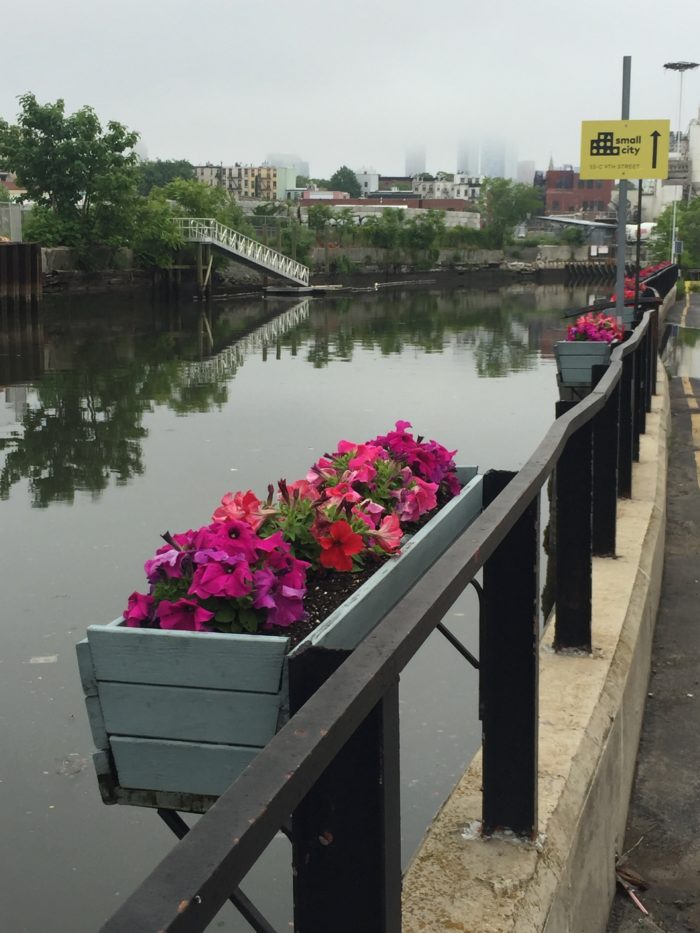
Petunias cheer up the Gowanus Canal shoreline at a small industrial park (Photo by Steve Koepp)
Turns out, a recurring theme of the conversation is how much, as humans, we’re all deeply affected by the water’s edge. The relationship keeps changing, from Native Americans harvesting oysters the size of dinner plates, to giant factories employing thousands, to industrial decline and neglect, and now a revitalization. “As people, we still want to gravitate toward the shoreline,” observed Marilyn Symmes, curator of the new photo exhibit, Shifting Perspectives: Photographs of Brooklyn’s Waterfront, at the historical society’s new space in Dumbo. Some of the effect is simply existential, she said, connecting us with a world beyond. “The ocean can give us a sense of the universe.”
Egan, who won the Pulitzer Prize in 2011 for A Visit From the Goon Squad, was a natural choice to moderate a panel on the water’s edge. For years she has been immersed in research for her forthcoming novel, Manhattan Beach, about a woman who works repairing ships in the Brooklyn Navy Yard during World War II and becomes the first female diver there. Egan said the Navy Yard was “like a secret city,” and that her research took her into the realm of underwater diving, waterfront gangsters, and the Merchant Marine. “I kept having the thrilling sense that I was getting on board a ship,” she said.
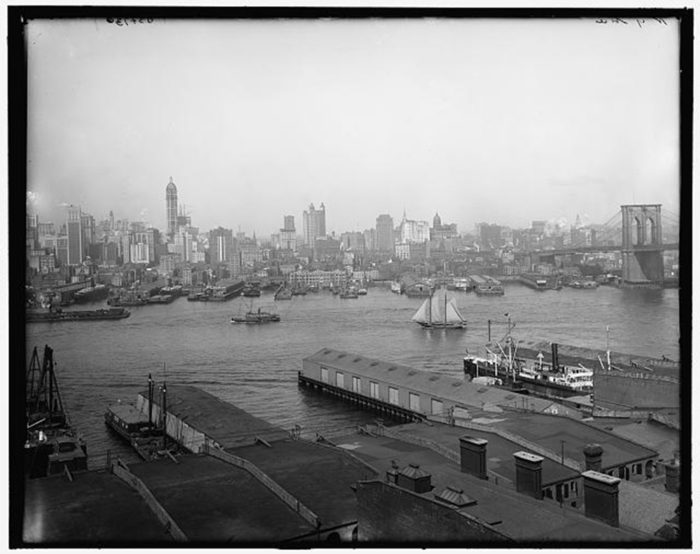
Looking across the East River toward Manhattan, around 1905 (Photo courtesy of the Library of Congress)
The panelists reflected on their earliest memories of the water’s allure. “I’m a Pisces and I was born in San Francisco, surrounded by water. If I were an animal, I’d want to be an otter,” said Nathan Kensinger, a photographer and filmmaker who explores hidden urban landscapes. As it happened, when Kensinger moved to Brooklyn, he found himself living near the notoriously polluted Gowanus Canal. As an artist, he found it inviting. “Gowanus was my backyard, a fascinating place to explore, take photographs, and do art exhibitions.”
Kensinger describes himself as an explorer of “liminal spaces,” which is an apt description of why the waterfront is so intriguing to artists, journalists, and scientists. It’s a transitional space, a marginal zone, offering surprises. Nicki Pombier Berger, an oral historian and educator, said she became fascinated by New York City’s waterways when she read a story in New York magazine about all the strange things divers have found beneath the surface, including a grand piano and scrapped ice-cream trucks. She developed a passion for exploring further, which led her to launch the digital journal Underwater New York.
The transformation of New York City’s waterways was a deliberate if not totally coordinated process, championed by mayors, real-estate developers, and environmentalists. Yet as the waterfront is cleaned up, the process sweeps aside the rubble that served as a kind of archaeological ruin. Egan recalled that when she moved to New York City in the late 1980s, she used to “jump over piles of jumbled concrete along the West Side,” which is now the scenic greenway of Hudson River Park. She acknowledged “a little feeling of loss in losing the rough edges.”
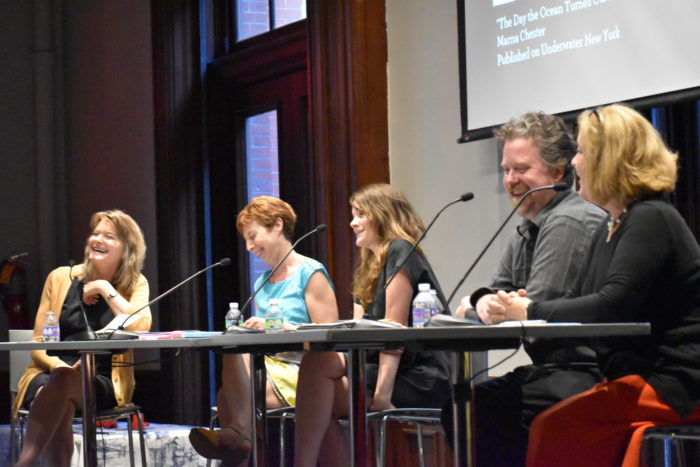
Egan, Albert, Berger, Kensinger, and Symmes in the panel discussion at the Brooklyn Historical Society (Photo by Steve Koepp)
Kensinger said he has felt urgency about capturing images of the city’s old industrial plants, the sugar refineries and shipyards, before they’re torn down. “Most of the industrial waterfront is a thing of the past. I miss all that stuff,” he said. (In a nod to that sentiment, the developers of the old Domino Sugar refinery in Williamsburg are creating a park that will include artifacts from the factory, including syrup tanks and gantry cranes.) Visual artist Elizabeth Albert, author of Silent Beaches, Untold Stories: New York City’s Forgotten Waterfront, said the city’s jagged edges have important stories to tell, visually and socially. “I’m always a little territorial about the edge–the edge of the edge,” she said. “It’s great to see the city improved, but you lose these layers of history when everything gets covered over.”
The cleaning-up of those spaces raises questions about what to preserve and how to do it, said Berger. One of her favorite places to explore is Dead Horse Bay, along Brooklyn’s south shore, so named for many long-gone rendering plants and their tossed-off carcasses. The bay shore is “kind of a star” among artifact hunters, serving up glass bottles, chunks of linoleum, shoes, and bones, Berger said. She bemoaned the lack of any organized “archeological effort,” since the place is “strange and mysterious and full of stories,” she said. “People just keep taking stuff.”
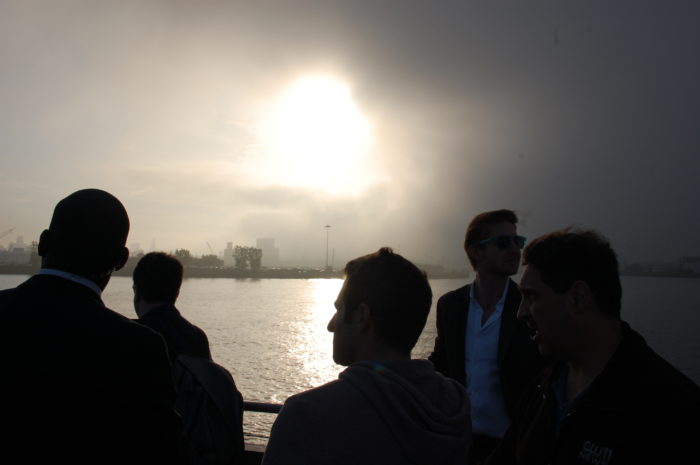
Passengers at sunrise on the NYC Ferry’s South Brooklyn Route (Photo by Steve Koepp)
The growing awareness of the waterfront among New Yorkers, Egan observed, was accelerated by Hurricane Sandy and its 14-foot storm surge. “I think it was possible to live in New York and not think about the water until Sandy, and then, ‘Wow, there’s a lot of water around here!’” Kensinger said he has been exploring the ways New Yorkers are responding to that vulnerability, some by rebuilding but others with very different approaches. “Some neighborhoods on Staten Island have decided to move. On the other hand, some neighborhoods have tens of thousands moving closer to the waterfront,” he said, which poses major issues for what the future will bring, given climate change and rising sea levels. “Are we going to retreat from the water, accommodate the water, or put lots more people in the path of the water?” (Ironically, the historical society’s new Dumbo location is in one of those areas that flooded during Sandy, but the Empire Stores facility has prepared a novel way to protect itself from the next storm surge.)
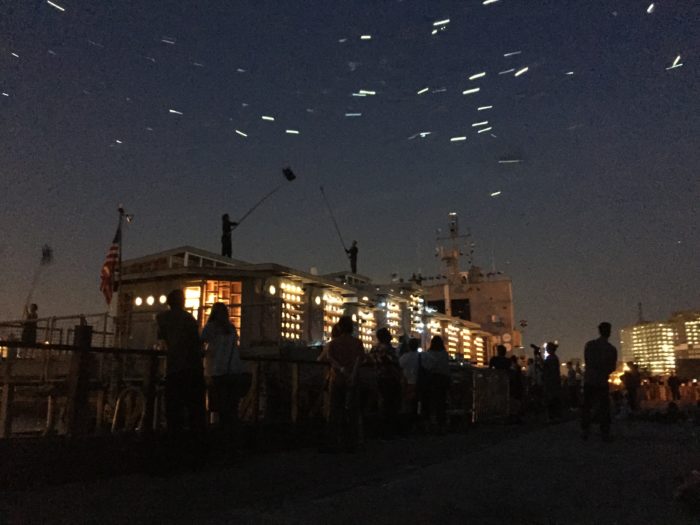
Trained pigeons carrying lights swirl in the sky above a barge/coop in the Navy Yard during a performance of Duke Riley’s “Fly By Night” last year (Photo by Steve Koepp)
Artists have a role in helping New Yorkers think about these policies by heightening their awareness of the waterfront–past, present, and future. “There needs to be creative thinking to figure out what should be done. You need architects, artists, scientists, filmmakers,” said Symmes, to create “an integrated dialogue to enlighten our politicians.” She praised recent artwork including A Subtlety, or the Marvelous Sugar Baby, by artist Kara Walker at the former Domino Sugar compound, as well as performance artist Duke Riley’s Fly By Night, in which LED-bearing homing pigeons performed in the Navy Yard. Albert, for her part, said she’s working on a children’s book about “the resiliency of the waterfront.”










